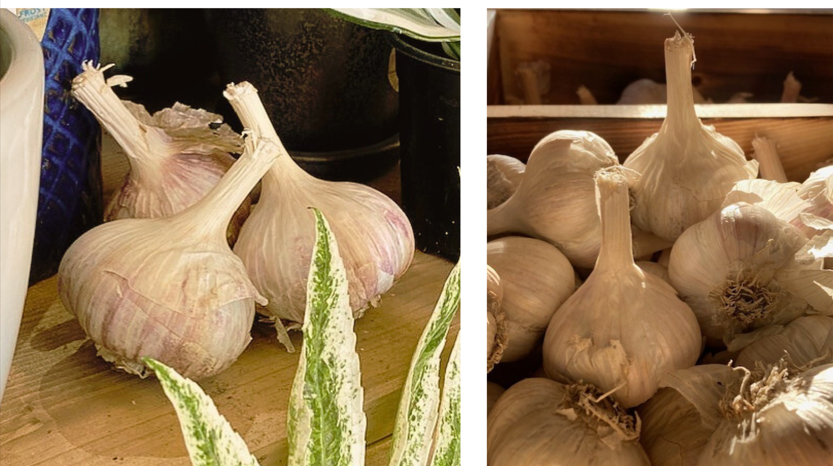
Garlic is an absolute POWERHOUSE in the kitchen, and on the tastebuds. It is one of the easiest things to grow! With good tips from the start, you will be planting and harvesting garlic before you know it, and saving your own seed to boot! Let's talk garlic: how to plant, when to plant, and all of the amazing benefits for your health, AND garden! This pungent bulb is known to keep pests at bay, and is also one of the oldest natural remedies used for centuries.
We all know garlic packs a flavourful punch (and keeps vampires away!), but it is also an extremely healthy superfood...
Garlic Benefits: Health & the Home Garden
Garlic is an age-old food source with the added benefit of medicinal use. We all know garlic packs a flavourful punch (and keeps vampires away!), but it is also an extremely healthy superfood which has been used for a number of ailments over the centuries. To name a few, it is said that garlic can improve blood pressure, reduce cholesterol, and strengthen bones. On top of that, regular use of garlic can improve skin, make for a better memory, stronger bones, and aid in kicking colds and flus to the curb. The list is long…and its benefits to the home garden are no exception!
Garlic is an incredible companion plant and pest deterrent. The strong aroma can repel the most relentless of insects. The sulfur in the bulb is said to keep many types of soil-borne fungi from becoming an issue in your garden. Some consider garlic a great companion plant to almost anything in the garden, though there are a few crops that are not ideal as they compete for similar resources, such as peas, beans and asparagus.
The plant also attracts beneficial predatory insects, such as ladybugs and lacewings, and is also known to repel borers, weevils, and fruit flies. Its antifungal properties can protect against apple scab in apple trees, and leaf curl in peach trees. Planting garlic around fruit trees not only keeps insects and other grazers at bay, it also adds a useful layer to the understory, acting as a living mulch where weeds would otherwise creep in.
Garlic can repel mites and aphids as well, so planting it near crops prone to these issues can help greatly. For example, planting these tasty cloves around roses can keep ants, snails, spider mites, and even blackspot fungi from attacking your classic blooms.
It is quite the small but mighty bulb in terms of flavour and garden protection, deterring pests as big as elk and deer, as well as smaller mammals like rabbits, mice, and squirrels.
How to Plant Garlic
In the East Kootenay region of BC, we generally plant garlic in mid October. The garlic will establish roots over winter, even if you don’t see any top growth. The cold period, or vernalization, is essential for hard-neck varieties in forming nicely-sized bulbs. We carry multiple varieties suitable for our region at our garden centre in Cranbrook BC, where you will also receive expert advice if you are new to garlic planting!
Choose a spot in the garden with full sun and rich, well draining soil. These alliums are quite forgiving with soil types, but good drainage is key. A soil with a pH of 6.5 to 7 is most desirable. If your soil happens to be too acidic, you can add lime or amend with organic matter, like worm castings, compost, or finely chopped leaf litter. On the other hand, if your soil is overly alkaline you may choose to add sulfur, or amend with peat moss, pine needles, or sawdust, which will slightly increase acidity. Visit us in-store if would like to learn about soil testing, and to find a soil test kit!
While you may buy seed garlic as a full bulb, you will want to plant individual cloves. Be sure to pull apart the bulb, and leave as much of the paper husk on as you can. Each individual clove will turn into a full bulb come harvest time! You will want to plant the clove pointy end up (root side down), roughly 2" deep, to ensure the most success. Plant the cloves 4 to 8 inches apart and water them in well. You will not need to water again until spring!
Growing, Maintenance, & Harvest
As the weather warms, green shoots will appear as the aboveground growth of your garlic. Be sure to keep the planting area free from weeds as they can compete with garlic for nutrients. Regular watering is necessary, making sure the soil remains moist but not waterlogged. Remember that garlic roots are deep, so deep watering is more beneficial than frequent shallow watering. Water your garlic as usual, even as the leaves start to die off.
In early summer, a curly stalk known as a scape will emerge from the center of your garlic plant. While it’s edible and delicious, it’s a good idea to snip it off once it completes a curl. This encourages the plant to divert energy to the bulb, resulting in bigger garlic heads. You can then use the scapes for your culinary crafts, whether it is making garlic scape pesto, or simply slicing and dicing to sauté with your favourite veggies.
In our area, garlic is usually ready for harvest in early to mid summer. When the lower one-third to half of the leaves turn yellow-brown, and the rest remain green, it’s typically time to harvest. Stop watering your garlic for one week before harvesting to allow the soil to dry out to prevent rot. This also makes harvesting easie since the soil won't be wet , heavy, and compressed.
Use a garden fork or shovel to gently lift the bulbs from the ground. Resist pulling, as this can damage the stem leading to reduced storage life. Each dying leaf of the plant often represents a layer of paper wrapping the final cloves within your bulb!
Storing Garlic, and Saving to Replant!
After your successful harvest, you will want to prepare your garlic for a long-lasting shelf life! Let the freshly harvested bulbs dry and cure in an airy, shady spot for about 3 weeks. Lay them flat or hang them up, ensuring the bulbs don’t touch each other.
After this period, it is safe to trim the roots. You can either cut the stalks or braid them for storage. It is important to store your garlic in a cool, dry place, with good air circulation to avoid mold. If you have any bulbs that show signs of damage or rot, use them up first, as they won’t store as long.
Save your biggest and healthiest bulbs to use for seed for autumn planting. Let the cycle continue, and you won't need to buy seed again until you want to try new varieties! Unless you eat them all, of course!
In conclusion, you simply cannot go wrong with garlic. It's the perfect beginner crop if you are just starting out with gardening, and has so many great uses you won't regret giving it a try! Our garden centre associates are always happy to help if you ever need some assistance in growing!











